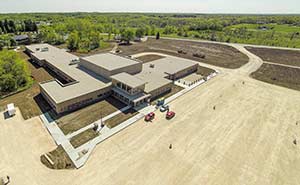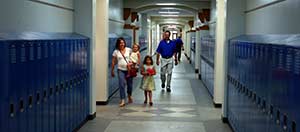It was a day 10 years in the making for St. Francis Borgia Parish, Cedarburg.
 The St. Francis Education and Activity Center features a Science, Technology, Engineering, Mathematics (STEM) lab and 26 classrooms that can accommodate 500 students. With the help of a drone, parishioner Bob Schatzman took an overhead image of the new facility. He also documented the construction from August to May, taking an estimated 15 to 20 million still pictures. (Submitted photos courtesy Bob Schatzman)It took three capital campaigns and more than $10 million in funding from 1,350 donors, but on Sunday, Aug. 9, hundreds of parishioners gathered in the gymnasium of the new, 60,000-square-foot Education and Activity Center at 1425 Covered Bridge Road to mark what all seemed to agree was a new era in the parish’s 173-year history.
The St. Francis Education and Activity Center features a Science, Technology, Engineering, Mathematics (STEM) lab and 26 classrooms that can accommodate 500 students. With the help of a drone, parishioner Bob Schatzman took an overhead image of the new facility. He also documented the construction from August to May, taking an estimated 15 to 20 million still pictures. (Submitted photos courtesy Bob Schatzman)It took three capital campaigns and more than $10 million in funding from 1,350 donors, but on Sunday, Aug. 9, hundreds of parishioners gathered in the gymnasium of the new, 60,000-square-foot Education and Activity Center at 1425 Covered Bridge Road to mark what all seemed to agree was a new era in the parish’s 173-year history.
“After 10 years, this day has finally arrived,” said Fr. Tom Eichenberger, an advocate of the building’s construction since being installed as pastor in 2003, while addressing the crowd at the dedication ceremony. “Literally thousands of hours of planning, meetings, decisions, three capital campaigns, (and) so much more has gone into the past 10 years of planning for this magnificent facility.”
The 1 p.m. dedication ceremony, which was attended by Archbishop Jerome E. Listecki and other representatives of the archdiocese and local government, was a moment of sweet celebration for a parish which had faced – in the words of Fr. Eichenberger – “insurmountable challenges and burdens” to see this project through to its completion.
“The delays and roadblocks were almost overwhelming,” he said in his remarks. “A couple of years ago there was a point of weariness … when the parish was on the verge of giving up. The mantra over and over again was, ‘When will we see a shovel in the ground?’”
He went on to describe the facility, which features a Science, Technology Engineering Mathematics (STEM) lab and 26 classrooms that can accommodate 500 students, as an “icon.”
“An icon is religious art in the Orthodox style, but an icon is also something that represents much more than just what it is. It is a living embodiment,” he said. “So if this building stands for, even shouts out, our Christian faith, our love for the Catholic Church, our commitment to children and to their moral and faith upbringing, our embracing of the future, it is for the greater glory of God. This building is the epitome, the embodiment, the fulfillment of our parish mission statement, which is share Christ, celebrate Christ, live Christ.”
Desire to be one-campus parish
In his remarks at the dedication ceremony, Archbishop Listecki noted “an excitement about Catholic education in the  A family tours the new facility during a dedication ceremony and open house for the Education and Activity Center at St. Francis Borgia Parish, Cedarburg, on Sunday, Aug. 9. (Catholic Herald photo by Allen Fredrickson)Archdiocese of Milwaukee – tremendous excitement … and the St. Francis Borgia activities center is a piece of that total package of excitement.”
A family tours the new facility during a dedication ceremony and open house for the Education and Activity Center at St. Francis Borgia Parish, Cedarburg, on Sunday, Aug. 9. (Catholic Herald photo by Allen Fredrickson)Archdiocese of Milwaukee – tremendous excitement … and the St. Francis Borgia activities center is a piece of that total package of excitement.”
Plans for the Education and Activity Center, dubbed the E&AC, have been in the works for at least 15 years, Fr. Eichenberger told the Catholic Herald in an interview after the dedication. The 40-acre parcel of former farmland upon which the building sits, situated directly north of the parish’s main church, was purchased around the year 2000 by former pastor Fr. George Gajdos.
Bringing all parish operations to one central campus has been a priority since 2001, when St. Francis Borgia merged with then-Divine Word Catholic Church. Weekend liturgies are celebrated at the former Divine Word Church at 1375 Covered Bridge Road, a facility built in 1970. Weekday liturgies and weddings have been held at the historic 1870 St. Francis Borgia Church on the corner of Hamilton Road and Washington Avenue in downtown Cedarburg – next to the three-level, 44,000-square-foot facility that has continued to house the parish’s school of approximately 325 students for over six decades.
Facility brings family together
“When the two parishes merged, we wanted to be a one-campus parish,” said Fr. Eichenberger. “There’s a synergy when you’re all on the same property. One program helping another, one person helping another. It’s just like they say in a marriage – it’s one plus one equals two, but there’s a greater power there. It’s the same in a church. When you have everybody together there’s a greater energy there than there would be with two split campuses.”
Parishioner Jerry Edquist, involved in the project since its inception, agrees.
“It’s kind of like if you’re raising a family and part of your family’s going on activities over here, and you don’t really see at one table what’s happening with the family,” he said.
The old school building, completed in 1951, was rife with inefficiencies, said Edquist. In addition to a boiler that constantly broke down, the layout was just barely able to accommodate both the schoolchildren and the parish’s 600 Christian formation students. Only middle school students were able to have lockers, and most classrooms featured only two outlets – a nightmare for implementing newer, technology-dependent educational practices, said principal Kelly Swietlik. The old school’s gym had to do double-duty as the lunchroom, and the building was not ADA accessible.
Now, Christian formation classes can be held every week instead of every other week. Every child has locker space, there are dedicated rooms for art and language as well as music and theater programs. The one-level building features more room for collaborative learning, a high-efficiency HVAC and boiler as well as energy efficient fluorescent and LED lighting.
The E&AC will also benefit parish members whose children are long out of school, said Swietlik, who is looking forward to being able to implement programs for the community’s older members.
“(For years) we’ve talked about a tech class for our seniors,” she said. “Well, our building was not accessible. So we’re looking forward to really making this a parish education and activities center that will offer things not only for the day school kids but for everyone.”
Project nearly doomed by rising construction costs
The original plan for the E&AC was the brainchild of a long-range planning commission established in 2004. The parish launched its first capital campaign, “In the Spirit of the Future,” in late 2006. The campaign intended to shed light on how much support there would be for the long-range planning commission’s recommendations, which included a two-phase master plan for the construction of an education and activities center. Cedarburg’s Groth Design Group was selected as the project architects.
Though the appeal was met with enthusiasm from parishioners and raised more than $5 million, there were factors working against its success.
“It’s been a lot of starting and stopping,” said Swietlik. “As we were working on (In the Spirit of the Future), construction costs were going up. So even though the campaign was successful, it wasn’t going to be enough.”
The housing market crash also meant that the parish might not get enough money for the old school and property. A status report published in November 2008 indicated that parish leadership was considering several lower-cost, alternative plans that included updating the old school building.
In May 2009, the parish announced a plan that would allow them to build the E&AC on the farmland at Covered Bridge Road, to be financed with a combination of already-donated money from the first campaign, proceeds from the future sale of the old school, collection on outstanding building pledges and revenue from the upcoming archdiocesan-wide Faith in Our Future Campaign.
But the project still had roadblocks. The archdiocese’ declaration of bankruptcy in 2011 further lowered the potential for donations; a 2012 Wisconsin Department of Transportation study suggested rerouting Highway 60 straight through the proposed site of the E&AC.
“You just try to keep your chin up,” said Fr. Eichenberger of the challenges to the project, and in September 2013, a campaign was launched by St. Francis Borgia to complete the project once and for all.
Project reached ‘now or never’ point
“About two years ago the buzz was, ‘We’ve got to get this done. It’s going to be now or never,’” said Switlik. “They regrouped with – ’the final relay team,’ is what I call them (parishioners Gerry Schwarz, Jim Michaletz, Andy Lampereur, and Jerry and Peg Edquist) – and they were not taking no for an answer.”
The team managed to rally 15 “catalyst donors” who pledged $1.2 million to jump-start the project. The fundraising efforts eventually exceeded the parish’s $2.1 million goal, and at long last, the groundbreaking ceremony was held in August 2014 — 10 years after the original long-range planning commission’s inception.
‘Catholic education for 100 years to come’
St. Francis Borgia has engaged the services of property broker DTZ Barry to sell three parcels that defined the old school property – the school itself and Fr. Ed Center that comprised the old parish offices, as well as the parking lot and a vacant lot. The asking price is $1.5 million and interested parties had to submit offers by mid-August.
Construction on the E&AC was meticulously documented over the past year by parishioner Bob Schatzman, who maintained a blog at sfbeac.com detailing the project’s progress. Schatzman, a lifelong photography buff, stopped by the construction site every morning, often bearing donuts and coffee for the workers, and set up three to five waterproof, dustproof GoPro cameras which would each yield about 20,000 still pictures a day.
Schatzman estimates he took about 15 to 20 million still pictures — he also utilized a drone camera — from August to May, the best of which were used to create a four-minute video shown at the dedication.
Two of Schatzman’s children are students at St. Francis Borgia, and he said his son Matthew is particularly enthusiastic about going to school in the new facility.
“It’s one of those things (from the perspective of a child) – ‘Oh yeah, yeah, they’re still talking about it; they’ll build it someday.’ To actually see it come together … was just so much fun,” he said. “He was very impressed – ‘We’re going to have a locker room, we don’t have to change in the bathroom!’”
Echoing Matthew Schatzman’s enthusiasm was his school principal, one of the original members of the long-range planning commission who first suggested the E&AC 10 years ago.
“By building this building, I believe that we’ve ensured Catholic education in Cedarburg for 100 years to come,” said Swietlik.
